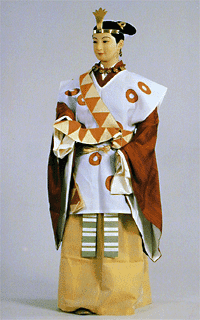|
Her first successful conquest in Wakeworld was Himiko (born c.154). Himiko was of the bloodline of Amaterasu, born into the So family, a hereditary line dedicated to the worship of the gods of Japan (including Amaterasu), and because of her extremely strong dreaming power was recognized as the leading oracle. The name Himiko, in fact, was a corruption of the name Himuka, which Amaterasu had used centuries earlier when the Hyuga tribe was just beginning to expand in present-day Miyazaki. Her kingdom (Yamatai) was one of several major kingdoms in the region around present-day Kyoto and Nara, each ruled by a King. The Yamatai were recognized as the religious leaders of a loose confederation, due to the strength of their So oracle group. Amaterasu happened on the scene in about 182, sharing Himiko's mind and body, and shortly thereafter the Yamatai king died (c.184). He had not designated a successor, and had no sons, so that a civil war seemed likely, but suddenly the heads of the two opposing camps suddenly announced their support to make a neutral third party, namely Himiko, Queen. (It was noted that the hair of one of them had turned pure white the prior night, while the other had apparently suffered a minor stroke, often drooling or bursting into tears. Both died within a week.)
Queen Himiko was generally acclaimed by the people, as she was already well known as the leading oracle. Yamatai immediately began a period of astonishing development and expansion. First, her kingdom suddenly made the transition from the late stone age directly into the iron age, providing quantum leaps in agricultural production and armament. Within a short period Yamatai was recognized as the overlord of 28 protectorates (formerly independent kingdoms) throughout Japan (Kyushu, Shikoku and all of Honshu except the northern tip) and most of the Korean Peninsula. With her power base established, she sent emissaries to the court of the Northern Gi Emperor of China, and was recognized as an affiliated state nominally under the control of China. This was the first step in her plan to control not only all of Japan, but indeed China, Asia and the world. Along the way, she also the name of her growing empire to Yamato.
According to the Chinese histories, Himiko lived in a heavily fortified palace complex, surrounded by walls and guard towers, and was attended by a thousand maidens. She never married, and apparently never toNashime visited the Chinese coTo assist her in her plans, she had four lieutenants, who used the names of their positions in the older agricultural Yamatai, namely the Lord of Horses (umaka), the Lord of Oxen (ushika), the Lord of Dogs (inuka, and the Lord of Swine (inoka), collectively kFrom about 243 rebellions broke out as local protectorates became unable to stand her continuing depredations on their population for unspeakable rites. She was known to practice black magic (kido), as well documented in a number if Chinese histories. The knowledge of iron-working had spread, reducing the edge that her own military had formerly enjoyed, and she requested aid from China in 244 to assist her in defeating her major threat, Kuna. In 245 China dispatched a large group of military advisors under Zhang Zheng, who brought with them a strange yellow battle standard (huang-chuang) that struck fear into the enemy troops. They entrusted the standard to Nashime, who was in Taiho at that time. The northern Korean kingdom of Koguryo, at that time revolting against Northern Gi rule, suddenly attacked Taiho as well, killing the governor there, named Gong Sun. Nashime took command, and used the standard to destroy Koguryo opposition, later being appointed governor of Taiho. He went on to use it successfully to destroy all remaining opposition to the Yamato Kingdom in Japan as well.
Unfortunately, Empress Himiko's magic and forbidden knowledge did not include medicine, and she died of liver disfunction due to malaria in 248, without an heir. While her personal guidance of the growing Yamato Kingdom had ended for a time, new rulers continued to carry out her plan for the eventual domination of the world. With her death, the nation quieted down as strictly political rulers took the reins of government, and the shoka dropped out of sight for a time. In 255 another woman assumed the Yamato throne, Queen Toyo, but Amaterasu was not involved, and she proved a lackluster if adequate ruler.
|



